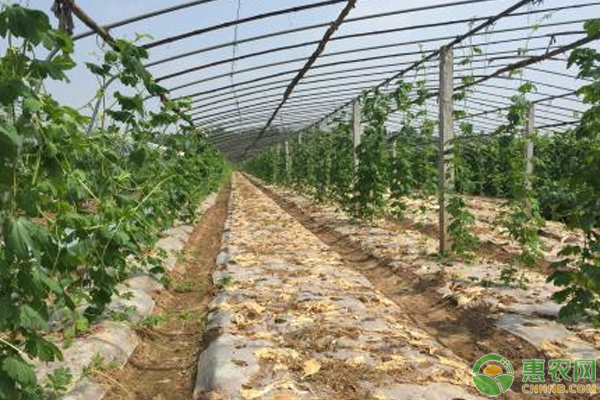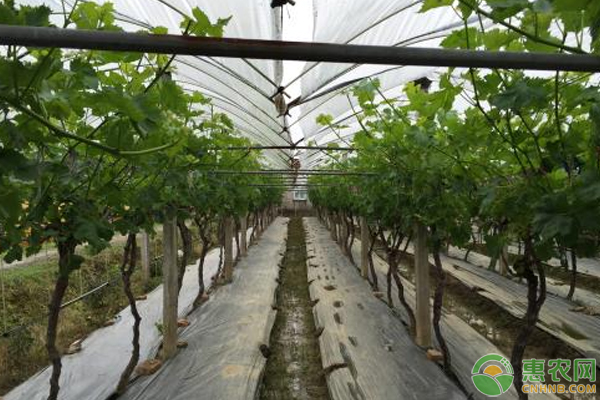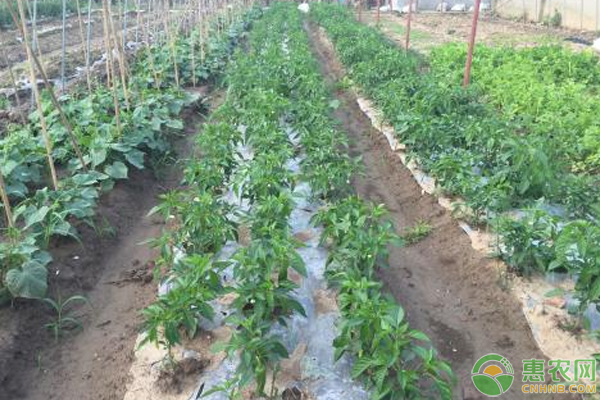How to grow organic vegetables? Organic vegetable planting technology in greenhouse and green control method for pests and diseases
Organic vegetables are currently very popular dishes. In recent years, with the improvement of people's living standards, the dietary requirements are getting higher and higher. Organic vegetables are more popular in terms of nutrition and safety, and have good market prospects. The following small series will tell you about the organic vegetable cultivation technology in greenhouses and the green prevention and control methods of pests and diseases. 1 greenhouse organic vegetable cultivation technology 1.1 Choosing the right vegetable variety To select organic high-yield and high-efficiency vegetable varieties. Nowadays, there are many genetically modified vegetables and genetically modified vegetable seedlings. These vegetable varieties have not been professionally identified and tested for quality. The growers should choose non-GM varieties. It is advisable to select the seedlings with better phase and the growth of roots and leaves is relatively complete. First choose the vegetable seedlings that have not been treated with drugs. The vegetables that have passed the test and passed the test should be selected to ensure the safety and reliability of the vegetables grown in the greenhouse. 1.2 Select a suitable planting base The greenhouse vegetable greenhouse temperature is based on solar radiation. Therefore, the planting base should be selected in a place with sufficient sunlight to enable the crop to fully receive sunlight, and photosynthesis can be used to promote the growth of the plant. Avoid using the mountain estuary, the foot of the mountain, and the low-lying land as a greenhouse. Vegetable field. Usually, there are three requirements for land. 1) Choose a relatively complete land, and there should be no other regular vegetables in the land, which can better ensure the balanced growth of organic vegetables in greenhouses. 2) Planting organic vegetables separately from ordinary vegetables. In order to distinguish the two more clearly, a clear mark should be established at the dividing line. 3) When planting organic vegetables, we must pay attention to the planning and management of the surrounding land. Some vegetables around the vegetable planting area should be converted into organic land. This part of the land cannot be planted at will. Only by doing the above three points can we achieve the sustainable development of organic vegetables in greenhouses. 1.3 Cultivation and management of vegetables Vegetable cultivation management is also one of the key factors for organic vegetable cultivation in greenhouses. To better improve the quality of planting and planting efficiency of organic vegetables, the importance of organic vegetable cultivation management should be fully recognized. Cultivation technology should keep pace with the times and introduce modern management equipment in time. 1.4 Rational fertilization Organic vegetables in greenhouses have higher requirements for fertilizers, which requires fertilisers to strictly control the amount of fertilizer and fertilizer types during the use of fertilizers. The choice of organic vegetable fertilizer should be based on pure natural fertilizers, such as animal manure, plant spoilage, etc. Pure natural fertilizers are not only environmentally friendly, but also do not produce a large amount of toxic substances that endanger human health. Scientific and rational fertilization is the key to improving the cultivation of organic vegetables in greenhouses. When selecting fertilizers, it is necessary to eliminate the use of chemical synthetic fertilizers, but you can choose some special fertilizers certified by professional institutions. Only scientific fertilization can ensure the safety of organic vegetables. . 2 Green pest control technology for greenhouse vegetables 2.1 Green control technology for pests 2.1.1 Light trapping Using insects with phototaxis, the production of insecticidal lamps to trap pests is a very important agricultural pest physical control measures, and is also an important part of comprehensive prevention and control. At present, insecticidal lamps for crop pests mainly include solar insecticidal lamps and electric insecticidal lamps. The use of insecticidal lamps to eliminate phototaxis pests, eliminate the large number of pests and not pollute the environment, this technology is easy to use. 2.1.2 Sex hormone trapping The use of certain sex-related chemicals secreted by the pest itself to trap male adults. At present, synthetic sex hormone products have sexual attractants, sexual stimulators, and sex control agents. Among them, sexual attractants can trap the designated pest species, such as Spodoptera litura, Plutella xylostella and other male moths have a lot of lethality, killing pests at one time and controlling the reproduction of pests. However, due to the large number of pests, the types of pest sex pheromones are relatively few, and there are certain limitations when using this method, so the research on other pests needs to be deepened. 2.1.3 Swatch trap Using the coloration of insects, swatches are made to trap pests. At present, common color insecticidal boards are available in yellow or blue, such as Liriomyza sativae, aphids, whitefly, and other pest-like yellows. Yellow boards can be used to trap pests. It should be noted that the oil should be applied to the color plate every 7 to 10 days to avoid the effect of trapping the oil due to the drying of the oil on the color plate. 2.1.4 Insect nets to kill The insect net is made of a gauze with a small aperture and is used in combination with a greenhouse. The advantage of this technology is that it can effectively prevent pests from entering the interior of the greenhouse and avoid the erosion of vegetables from insects. On the other hand, it also has good light transmission and good ventilation properties, and does not affect the normal growth of vegetables . 2.2 Green integrated prevention and control technology for diseases The green control of vegetable planting diseases has the following points: 1) According to the soil conditions and geographical conditions of the region, it is the basis for controlling vegetable diseases by selecting high-yield, high-quality and high-yield varieties suitable for planting in the region. 2) High ridge narrowing and digging trenching, the purpose is to make the surface no water, even if it rains, it can quickly remove the accumulated water, reduce the temperature inside the shed and avoid disease. 3) After the harvest of the previous crop, the soil should be deeply ploughed in time. It is best to use the sunlight to varnish the ploughed soil for several days to reduce the disease in the soil. 4) Implement crop rotation to prevent soil-borne diseases. 5) Strengthen field management and timely remove the infected plants to ensure the healthy growth of vegetables. 2.3 Pest and pest ecological prevention and control technology Ecological control is mainly to prevent precautions. In many areas, there will be severe winds, heavy rains, hail and other disasters. When encountering such bad weather, organic vegetables in greenhouses will show condensation and greenhouses. Water leaks, etc., and bad weather can also affect the air quality in the greenhouse. According to the relevant research results, pests and diseases are more likely to occur in an acidic environment, so scientific and effective measures should be taken to control the pH of the planting environment. Planters can properly spray alkaline substances on the leaves, which can effectively reduce the probability of occurrence of pests and diseases. Although the market prospects of organic vegetables are good, the planting process is more complicated. Because it is purely natural and non-polluting, the field management needs to be more careful. The above is a detailed method of planting organic vegetables in greenhouses. Moisturizing is the foundation of skin care. The basic skin care products that are indispensable for moisturizing and hydrating such as lotions, lotions and essences, how in the end should I choose the real moisturizing products? The easiest way is to look at the active ingredients of the product. Common Cosmetic Ingredients series, common moisturizing ingredients, let's take a look. Moisturizing Raw Materials,Nourishing Skin,Aloe Vera Gel Powder Shaanxi Zhongyi Kangjian Biotechnology Co.,Ltd , https://www.zhongyibiotech.com


1, glycerin, the scientific name of propanetriol, glycerin can be classified as a natural ingredient moisturizer, mild texture, not easy to cause skin allergies, etc.. But glycerin itself is only moisturizing and no skin care function, so it works well for young, healthy skin. If the skin needs multifaceted maintenance, then the maintenance products also need to contain other effective ingredients and glycerin with the use.
2, collagen, collagen on the skin care although important, but its due to the molecular large, directly applied when not accepted by the skin. The real improvement of the skin collagen content is the use of collagen boosters, such as vitamin C, vitamin B3, vitamin A.
3, hydrolyzed collagen, hydrolyzed collagen is the large molecule of collagen to hydrolyze the processing into a small molecular weight of protein. The hydrolyzed protein is not as good as other moisturizers in terms of pure moisturizing effect, but has a certain function of improving skin texture. When you are shopping, make sure that the collagen in the maintenance products is labeled "hydrolyzed collagen", which is the collagen that can be absorbed by the skin. The actual fact is that you can find a lot of people who are not able to get a good deal on this kind of things.
4, amino acids, amino acid moisturizing mechanism and other moisturizers are different, it does not have a strong water absorption, but the skin moisture has a regulatory role, because the moisture content in the stratum corneum is reduced, the amino acid content at the same time reduced, so the maintenance products in the addition of amino acids is necessary to maintain the normalization of keratin function, but amino acids do not belong to the "main moisturizing factor "The main factor is the fact that it is not the main moisturizing factor.
5, natural moisturizing factor, the main components of natural moisturizing factor are amino acids, sodium lactate, urea, etc.. In pure moisturizing effect is not as good as glycerin, but because of its good skin-friendly, can regulate the skin pH function and maintain the normal operation of the keratin, not only has a moisturizing function, but also a certain maintenance function, is also indispensable moisturizing ingredients.